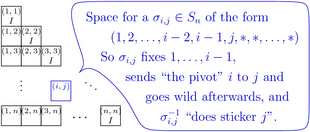|
|
| Line 1: |
Line 1: |
|
{{In Preparation}} |
|
|
{{11-1100/Navigation}} |
|
{{11-1100/Navigation}} |
|
|
|
|
Latest revision as of 08:11, 1 November 2011
| #
|
Week of...
|
Notes and Links
|
| Additions to the MAT 1100 web site no longer count towards good deed points
|
| 1
|
Sep 12
|
About This Class, Tuesday - Non Commutative Gaussian Elimination, Thursday - NCGE completed, the category of groups, images and kernels.
|
| 2
|
Sep 19
|
I'll be in Strasbourg, class was be taught by Paul Selick. See my summary.
|
| 3
|
Sep 26
|
Class Photo, HW1, HW1 Submissions, HW 1 Solutions
|
| 4
|
Oct 3
|
The Simplicity of the Alternating Groups
|
| 5
|
Oct 10
|
HW2, HW 2 Solutions
|
| 6
|
Oct 17
|
Groups of Order 60 and 84
|
| 7
|
Oct 24
|
Extra office hours: Monday 10:30-12:30 (Dror), 5PM-7PM @ Huron 1028 (Stephen). Term Test on Tuesday. Summary for the midterm exam. Term Test - Sample Solutions
|
| 8
|
Oct 31
|
HW3, HW 3 Solutions
|
| 9
|
Nov 7
|
Monday-Tuesday is November Break, One Theorem, Two Corollaries, Four Weeks
|
| 10
|
Nov 14
|
HW4, HW 4 Solutions
|
| 11
|
Nov 21
|
|
| 12
|
Nov 28
|
HW5 and last week's schedule
|
| 13
|
Dec 5
|
Tuesday - the Jordan form; UofT Fall Semester ends Wednesday; our Final Exam took place on Friday
|
| Register of Good Deeds
|

Add your name / see who's in!
|

See Non Commutative Gaussian Elimination
|
|
This assignment is due at class time on Tuesday, November 15, 2011.
Solve the following questions
Problem 1. (Selick) Show that any group of order 56 has a normal Sylow- subgroup, for some prime
subgroup, for some prime  dividing 56.
dividing 56.
Problem 2. (Qualifying exam, May 1997) Let  act on
act on  by permuting the factors, and let
by permuting the factors, and let  be the semi-direct product of
be the semi-direct product of  and
and  .
.
- What is the order of
 ?
?
- How many Sylow-5 subgroups does
 have? Write down one of them.
have? Write down one of them.
Problem 3. (Selick) Show that the group  of unit quaternions (
of unit quaternions ( , subject to
, subject to  and
and  ) is not a semi-direct product of two of its proper subgroups.
) is not a semi-direct product of two of its proper subgroups.
Problem 4. (Qualifying exam, September 2008) Let  be a finite group and
be a finite group and  be a prime. Show that if
be a prime. Show that if  is a
is a  -subgroup of
-subgroup of  , then
, then  is congruent to
is congruent to  mod
mod  . You may wish to study the action of
. You may wish to study the action of  on
on  by multiplication on the left.
by multiplication on the left.
Problem 5. (easy)
- Prove that in any ring,
 .
.
- Prove that even in a ring without a unit,
 .
.
(Feel free to do the second part first and then to substitute  ).
).
Problem 6.
- (Qualifying exam, April 2009) Prove that a finite integral domain is a field.
- (Qualifying exam, September 2008) Prove that in a finite commutative ring, every prime ideal is maximal.
Problem 7. (Dummit and Foote) A ring  is called a Boolean ring if
is called a Boolean ring if  for all
for all  .
.
- Prove that every Boolean ring is commutative.
- Prove that the only Boolean ring that is also an integral domain is
 .
.
Problem 8. (bonus) Let  be the ring of bounded sequences of real numbers with pointwise addition and multiplication, let
be the ring of bounded sequences of real numbers with pointwise addition and multiplication, let  be the ideal made of all sequences that are equal to
be the ideal made of all sequences that are equal to  except in at most finitely many places, and let
except in at most finitely many places, and let  be a maximal ideal in
be a maximal ideal in  containing
containing  .
.
- Prove that
 .
.
- Denote by
 the projection of
the projection of  to
to  composed with the identification of the latter with
composed with the identification of the latter with  , so that
, so that  . Prove that for any scalar
. Prove that for any scalar  and any bounded sequences
and any bounded sequences  , we have that
, we have that  ,
,  , and
, and  . (Easy, no bonuses for this part).
. (Easy, no bonuses for this part).
- Prove that if
 in the ordinary sense of limits of sequences, then
in the ordinary sense of limits of sequences, then  .
.
- Is there a
 for which
for which  is also translation invariant, namely such that
is also translation invariant, namely such that  ? (Again, easy).
? (Again, easy).
Warning. The right order for solving these questions is not necessarily the order in which they are presented.
Opinion. The sum total of all that is that using the axiom of choice you can construct things that are both too good to be true and not really useful anyway. Blame the axiom of choice, don't blame me.





































